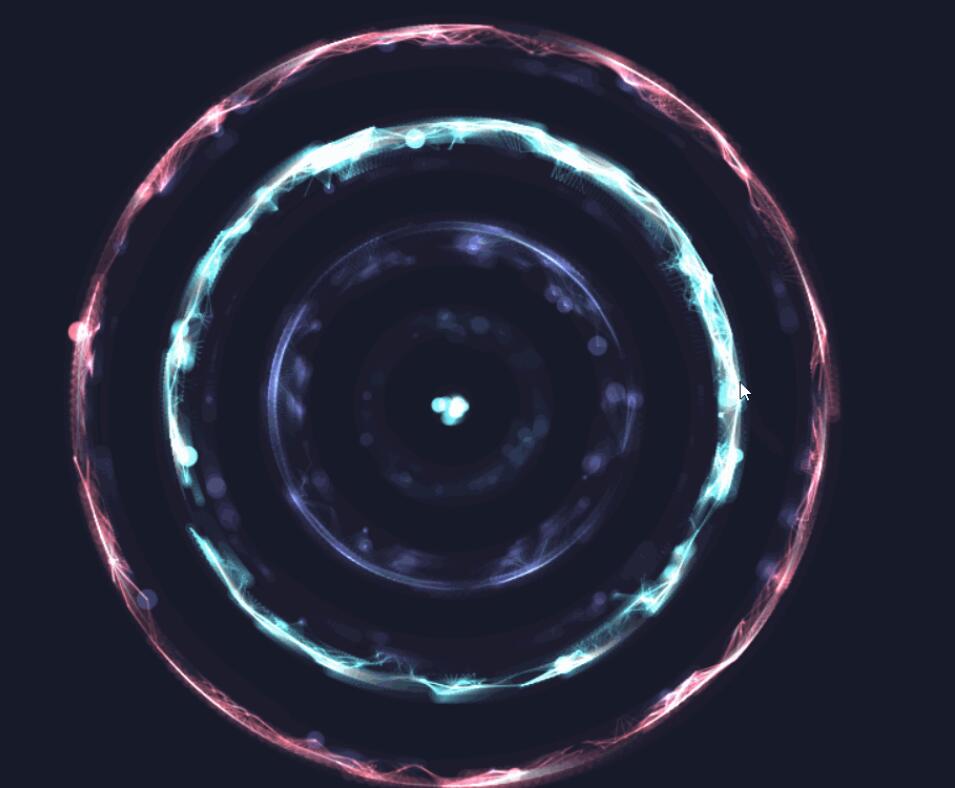js canvas实现圆形流水动画
本文实例为大家分享了canvas实现圆形流水动画的具体代码,供大家参考,具体内容如下
前言
特效展示
效果展示

代码展示
index.html
<!DOCTYPE html>
<html lang="en">
<head>
<meta charset="UTF-8">
<meta http-equiv="X-UA-Compatible" content="IE=edge">
<meta name="viewport" content="width=device-width, initial-scale=1.0">
<title>Document</title>
<!-- <link rel="stylesheet" href="style.css" > -->
</head>
<body>
<script src="main.js"></script>
</body>
</html>
main.js
/*
* Noel Delgado - @pixelia_me
*/
(function() {
var ctx, w, h, cx, cy, PI, PI_HALF, cos, sin, random, lineWidth, C,
rings, ringsLength, data;
ctx = document.createElement('canvas').getContext('2d');
w = 600;
h = 600;
cx = (w / 2);
cy = (h / 2);
rings = [];
ringsLength = 0;
PI = Math.PI;
PI_HALF = PI / 2;
cos = Math.cos;
sin = Math.sin;
random = Math.random;
lineWidth = 0.2;
C = ["#ABF8FF", "#E76B76", "#1D2439", "#4F3762", "#67F9FF", "#0C0F18"];
data = [
/* ring {t:total_particles, r:radius, d:distance, s:speed, c:color} */
[
{t:80, r:(cx-10), d:40, s:30, c:C[1]},
{t:60, r:(cx-20), d:40, s:80, c:C[2]},
{t:20, r:(cx-30), d:20, s:80, c:C[2]},
],
[
{t:80, r:(cx-80), d:40, s:40, c:C[4]},
{t:80, r:(cx-90), d:20, s:40, c:C[4]},
{t:20, r:(cx-100), d:20, s:40, c:C[2]},
{t:40, r:(cx-110), d:20, s:40, c:C[2]},
],
[
{t:60, r:(cx-160), d:40, s:20, c:C[2]},
{t:20, r:(cx-170), d:30, s:60, c:C[2]},
{t:40, r:(cx-180), d:40, s:60, c:C[2]},
],
[
{t:40, r:(cx-230), d:40, s:20, c:C[5]},
{t:20, r:(cx-240), d:20, s:10, c:C[5]},
],
[
{t:10, r:(cx-290), d:10, s:10, c:C[4]}
]
];
/* */
ctx.canvas.width = w;
ctx.canvas.height = h;
document.body.appendChild(ctx.canvas);
data.forEach(function(group) {
var ring = [];
group.forEach(function(orbit, i) {
var total_particles, index;
total_particles = orbit.t;
index = 0;
for (; index < total_particles; index++) {
var radius, distance, speed, color, opacity;
radius = orbit.r;
distance = orbit.d;
speed = random() / orbit.s;
speed = i % 2 ? speed : speed * -1;
color = orbit.c;
opacity = orbit.o;
ring.push(new P(radius, distance, speed, color, opacity));
radius = distance = speed = color = opacity = null;
}
});
rings.push(ring);
});
ringsLength = rings.length;
/* */
function P(radius, distance, speed, color) {
this.a = PI / 180;
this.d = distance;
this.d2 = (this.d * this.d);
this.x = cx + radius * cos(this.a);
this.y = cy + radius * sin(this.a);
this.c = color;
this.r = (random() * 8);
this.R = random() > 0.5 ? radius : radius - 5;
this.s = speed;
this.pos = random() * 360;
}
function draw() {
var i, j, k, xd, yd, d, ring, ringLength, ringLength2, particle, p2;
ctx.beginPath();
ctx.globalCompositeOperation = "source-over";
ctx.rect(0, 0 , w, h);
ctx.fillStyle = "#151a28";
ctx.fill();
ctx.closePath();
for (i = 0; i < ringsLength; i++) {
ring = rings[i];
ringLength = ring.length;
ringLength2 = ringLength - 100;
for (j = 0; j < ringLength; j++) {
particle = ring[j];
particle.x = cx + particle.R * sin(PI_HALF + particle.pos);
particle.y = cy + particle.R * cos(PI_HALF + particle.pos);
particle.pos += particle.s;
ctx.beginPath();
ctx.globalAlpha = 0.12;
ctx.globalCompositeOperation = "lighter";
ctx.fillStyle = particle.c;
ctx.arc(particle.x, particle.y, particle.r, PI * 2, false);
ctx.fill();
ctx.closePath();
for (k = 0; k < ringLength2; k++) {
p2 = ring[k];
yd = p2.y - particle.y;
xd = p2.x - particle.x;
d = ((xd * xd) + (yd * yd));
if (d < particle.d2) {
ctx.beginPath();
ctx.globalAlpha = 1;
ctx.lineWidth = lineWidth;
ctx.moveTo(particle.x, particle.y);
ctx.lineTo(p2.x, p2.y);
ctx.strokeStyle = p2.c;
ctx.stroke();
ctx.closePath();
}
}
}
}
}
function loop() {
draw();
requestAnimationFrame(loop);
}
loop();
})();
以上就是本文的全部内容,希望对大家的学习有所帮助,也希望大家多多支持我们。
赞 (0)

